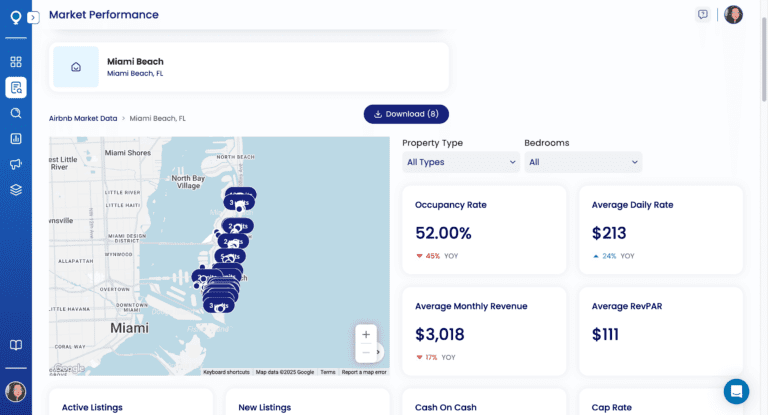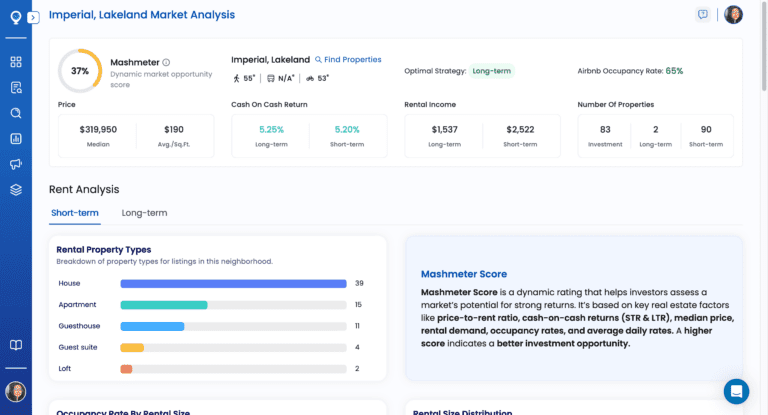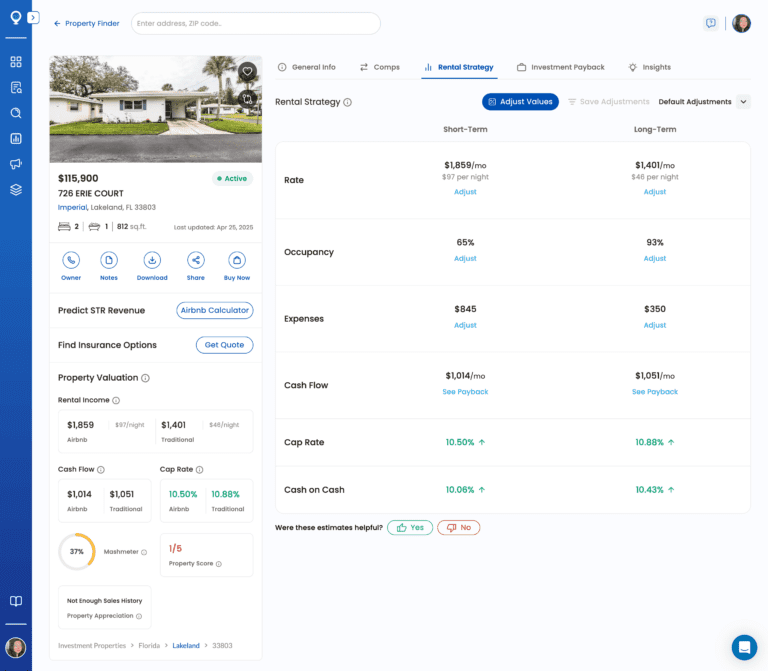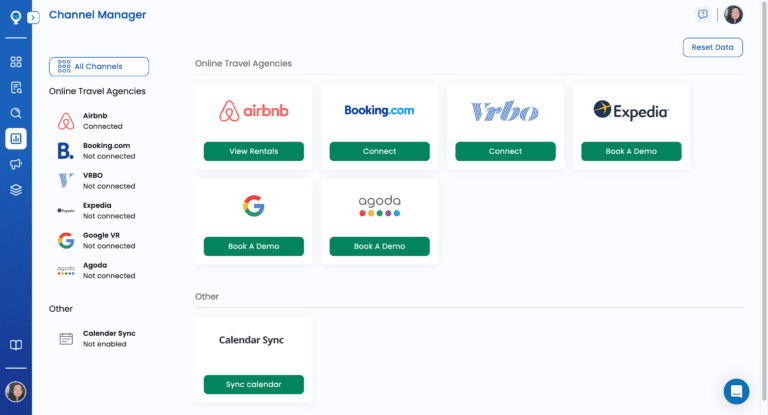Real estate investment software has revolutionized how Airbnb hosts find, analyze, and manage profitable short-term rentals.
Gone are the days of relying on hunches or scattered spreadsheets. Today’s data-driven platforms aggregate market trends, occupancy metrics, and neighborhood comps into easy-to-read dashboards.
These powerful real estate investment tools and rental property software empower you to:
- Identify high-demand markets instantly. Interactive heat maps and demand trend reports reveal where guests are booking the most, so you can invest with confidence.
- Forecast financial performance accurately. Automated ROI calculators model cash flow, cap rates, and break-even timelines before you commit, giving you clarity on potential returns and risks.
- Streamline operations through automation. From dynamic pricing updates to centralized guest messaging, you’ll eliminate tedious tasks and focus on scaling your portfolio.
In a landscape where every percentage point of occupancy and nightly rate matters, leveraging real estate investment software isn’t just smart, it’s essential. By harnessing data over guesswork, you’ll maximize revenue, mitigate risk, and build an Airbnb business that stands the test of time.
5 Key Features to Look for in a Real Estate Investment Software
Choosing the right real estate investment software can mean the difference between a guessing game and a precision-driven Airbnb strategy. The best platforms combine deep data with automation so you can confidently pick winning markets, model returns, and streamline operations.
Below are the core feature sets you’ll want to evaluate when comparing tools.
Market Analysis and Location Scouting
The first set of features of any real estate investment software worth trying is powerful market analysis tools that help you zero in on the neighborhoods primed for Airbnb success. Look for platforms with:
- Heat maps that visualize neighborhood pricing, Airbnb occupancy rates, and seasonal demand at a glance;
- Demand trend reports showing when and where bookings spike, so you can time your pricing; and,
- Occupancy-rate insights that benchmark your target area against regional and national averages.
Financial Modeling and ROI Calculators
Turning market intel into actual dollars is where real ROI is made. Your software should include cash flow forecasting modules to project real-world performance, including:
- Cash-on-cash return calculators to see how much cash you’ll pocket relative to your investment;
- Cap-rate analysis to compare yield across properties and markets;
- Break-even timelines that factor in financing costs, vacancy buffers, and operating expenses; and,
- Airbnb revenue simulators that model nightly rates and occupancy swings for short-term rental scenarios.
Pricing Optimization and Dynamic Pricing
Maximize every booking with data-driven pricing optimization:
- Automated rate recommendations that adjust nightly pricing based on local demand, events, and competitor rates;
- Seasonality adjustments to capture peak-season premiums and protect margins in the slow months; and,
- Integration with your channel manager so price updates flow instantly to Airbnb, VRBO, and other platforms.
Property Management and Automation
Scale from one listing to a full portfolio by offloading routine tasks:
- Channel manager functionality that unifies calendars, rates, and availability across platforms;
- Unified inbox for guest messaging, cleaning alerts, and maintenance requests; and,
- Task scheduling to automate turnovers, inspections, and follow-up communications.
Guest Screening and Risk Management
Protect your investment with built-in safeguards:
- ID verification to ensure every guest is who they say they are;
- Damage-deposit workflows that hold funds securely until checkout; and,
- Review analytics to flag patterns of problematic stays and maintain a five-star reputation.
By prioritizing these features in your real estate investment software, you’ll move beyond guesswork to a streamlined, data-powered Airbnb business that runs itself, so you can focus on growth, not grunt work.
The Top 5 Real Estate Investment Software for Airbnb
When you’re building a data-driven Airbnb portfolio, the right real estate investment software can accelerate every step, from market research to operations. Here’s how Mashvisor compares to other leading Airbnb analytics software and short-term rental tools.
Mashvisor
When it comes to real estate investment software built specifically for short-term rentals, Mashvisor sits in a league of its own. We designed every feature around the needs of Airbnb investors who want to move beyond spreadsheets and gut instincts to a fully data-driven strategy.
1. Predictive Analytics You Can Trust
Mashvisor’s predictive analytics engine ingests millions of data points—historic occupancy rates, seasonality curves, pricing fluctuations—to forecast future performance with remarkable precision. Instead of manually pulling numbers from multiple sources, you get instant projections for average daily rate (ADR), occupancy rate, and monthly rental income.
Our machine-learning models continually refine themselves as new data arrives, so your forecasts stay up to date.

Mashvisor collates data from different reliable sources to provide the best estimates, analyses, and forecasts
2. Neighborhood Comps That Go Deep
Comparable-sales analyses are standard in residential investing. But Mashvisor takes comps further by layering on short-term rental metrics.
You can compare any property against dozens of similar listings filtered by bedroom count, amenities, proximity to points of interest, and more.
The result? You can see what they earned from Airbnb, their nightly rates, and their occupancy rates. With this information, you can buy property with the best potential and set your nightly rates to outperform the market.

Mashvisor’s neighborhood analysis lets you dig deep on a locality’s investment potential.
3. Rental Estimator for Every Scenario
What if you want to test a conservative case with 60% occupancy? Or if you want to find out how soon you can earn back your initial investment with a $50,000 renovation budget?
Mashvisor’s rental estimator lets you spin up multiple scenarios in seconds. You can learn your monthly cash flow, cap rate, cash-on-cash return, and payback period.
This flexibility is critical when you’re comparing multiple markets or deciding between properties in the same neighborhood.

Adjust values to the rental rates, occupancy rates, expenses, and cash flow to estimate your cap rate and cash-on-cash return based on your strategy
4. Intuitive Dashboard and Custom Alerts
Even the most powerful analytics are useless if they’re buried in menus. Mashvisor’s dashboard surfaces your key metrics at a glance and lets you drill down only when needed.
Better yet, set custom alerts for when a new listing matching your criteria pops up. You’ll never miss an opportunity.

With Mashvisor, you can create custom alerts to get notified of any new properties for sale that meet your investment criteria.
5. End-to-End Automation
Mashvisor is not just for discovering properties to turn into Airbnbs. It also features a channel manager, a dynamic pricing engine, and multi-inbox capabilities.
That means your Airbnb calendar, rates, and guest communications can be managed in the same place you’re finding your next profitable investment. You reclaim hours of busywork every week, so you can focus on growing your investment rather than juggling tools.

Mashvisor’s channel manager lets you synchronize changes to your listings on all booking platforms.
Why Mashvisor Wins
While other platforms excel at individual tasks, like analyzing comps or automating messaging, Mashvisor brings everything together in an investor-first experience.
You don’t need a team of analysts or a toolkit of five different subscriptions. With Mashvisor, you get the complete tech stack for sourcing, analyzing, and managing Airbnb investments under one roof.
AirDNA
AirDNA is the go-to Airbnb analytics software for many hosts and investors who want granular booking data. It offers:
- Airbnb Revenue Calculator. Plug in an address or market, and AirDNA extrapolates potential earnings based on historical booking volumes and comparable listings.
- Custom Comps: Go beyond generic averages by building tailored peer groups. Filter by property type, amenities, or specific submarkets.
- Submarket Insights: Explore neighborhood-level performance to discover hidden pockets of high demand within larger metropolitan areas.
AirDNA’s strength lies in its range of historical data and easy-to-use web interface. Its visualizations make it simple to spot seasonality patterns and event-driven spikes.
However, it focuses primarily on analytics and doesn’t include built-in property management or financial modeling modules. You’ll need to export data to spreadsheets or plug into other tools for complete ROI calculations and automation workflows.
DealCheck
DealCheck shines as a quick-hit analysis tool for both short-term and long-term rental investments. Key features include:
- Quick Property Analysis. Enter basic property details and DealCheck calculates ROI, cash flow, cap rate, and more.
- Rehab & BRRRR Calculators. Evaluate renovation budgets, after-repair values, and refinancing scenarios for buy-rehab-rent-refinance-repeat strategies.
DealCheck is perfect when you need a speed check on a deal. However, it lacks dynamic pricing optimization and in-depth market trend visualizations, so it’s best used in conjunction with an Airbnb analytics software like Mashvisor for location scouting and pricing insights.
Hostaway
Hostaway positions itself as both a property management system (PMS) and a growth engine for professional hosts. Its core modules include:
- Channel Manager. Sync calendars and rates across Airbnb, VRBO, Booking.com, and direct-booking sites in real time, eliminating double-booking risk.
- Unified Inbox: Consolidate guest messages, cleaning alerts, and maintenance requests into one shared workspace.
- Automation Workflows: Create rule-based triggers (e.g., sending a welcome message upon booking or scheduling cleaners upon checkout) that run automatically without manual intervention.
In addition, Hostaway integrates with leading dynamic-pricing engines and accounting platforms, making it a solid operational hub.
While its reporting features cover occupancy and revenue, Hostaway doesn’t offer the same depth of market analysis or financial modeling found in dedicated real estate investment software. It’s best suited for hosts who already know where to invest and need to scale operations efficiently.
Guesty
Guesty is another comprehensive PMS and short-term rental tool that combines operational automation with investment-focused reporting:
- Unified Dashboard. Track occupancy, ADR, RevPAR (revenue per available room), and net operating income across all properties.
- Advanced Reporting. Generate investor-ready reports on financial performance, booking channels, and maintenance costs.
- API Integrations. Connect with dynamic pricing engines, CRM systems, accounting software, and third-party services like cleaning or key-exchange providers.
Guesty’s strength is its focus on mid- to large-scale operators who require both back-office efficiency and clear financial visibility.
However, while it offers solid short-term rental tools for managing listings and finances, Guesty’s market analysis capabilities are more limited compared to specialist platforms like Mashvisor. You may still need a dedicated market-scouting tool for pinpointing the next high-growth neighborhood.
Each platform brings unique strengths—deep historical analytics, rapid deal checks, or operational automation—but only Mashvisor delivers a proper end-to-end solution. As the most complete real estate investment software for Airbnb, Mashvisor empowers you to uncover opportunities, model returns, and automate operations all in one place.
How to Choose the Right Real Estate Investment Software for Your Strategy
Selecting the ideal real estate investment software isn’t a one-size-fits-all. Your choice should align with your specific goals, whether you’re optimizing your existing Airbnb listing or scaling a multi-property portfolio.
Use the following framework to guide your software comparison.
1. Define Your Investment Goal: Single Listing vs Portfolio
Single-listing investors need intuitive dashboards and an easy-to-use ROI calculator to quickly vet a handful of deals. Look for streamlined deal-analysis workflows, simple cash-flow forecasting, and a low learning curve.
Meanwhile, portfolio operators require advanced automation, multi-property reporting, and integrations. Look for tools with bulk-analysis features, centralized performance dashboards, and team-oriented permissions.
2. Evaluate Core Feature Fit
When evaluating core feature fit, start by considering which capabilities you genuinely need now versus those you may need down the road.
Dynamic pricing integration moves from a “nice-to-have” for part-time hosts into a “must-have” for those scaling up. At the same time, task scheduling and team permissions become crucial when coordinating cleaning, maintenance, and guest communication across multiple properties.
In short, match basic analysis tools to a single-property strategy, but prioritize automation, multi-property reporting, and advanced integrations as you acquire more properties.
3. Factor in Budget and Tool Pricing
Entry-level plans (ranging from $0 to $50 per month) often limit the number of listings, data depth, or features. These are ideal for single-listing experiments or part-time hosts.
Meanwhile, mid-tier plans (ranging from $50 to $200 per month) unlock advanced analytics, more listings, and basic automation. These are fit for investors with 2 to 10 properties.
Finally, enterprise plans (starting at $200 per month) offer unlimited listings, premium integrations, dedicated support, and custom reporting. Only choose these once your revenue justifies the investment.
Here’s a tip: always compare pricing tiers side by side and calculate your ROI. If a $100/month subscription boosts your revenue by $500, it pays for itself.
4. Review Integrations and Scalability
First, ensure your software syncs with Airbnb, VRBO, and dynamic pricing engines so data flows seamlessly.
Next, if you want accounting and guest communications, look for direct connections to QuickBooks, Xero, or your CRM to automate bookkeeping and guest relations.
And if you plan to use custom dashboards or proprietary automation, verify API access and developer support.
Lastly, your tool should be able to handle one listing today and 100 tomorrow without any performance hiccups or significant price increases to pass the scalability test.
5. Assess Support and Learning Resources
For this part, find out the following:
- Does the vendor offer live demos, video tutorials, or one-on-one onboarding?
- Do they offer 24/7 chat support, dedicated account managers, or a responsive ticketing system?
- Do they moderate an active user forum, host webinars regularly, and keep their documentation up to date to help you discover advanced features?
By mapping your investment style—single listing vs. portfolio—against feature sets, budget constraints, integration needs, and support expectations, you can conduct a thorough comparison of software. This ensures the real estate investment software you choose not only fits your current strategy but also scales as your Airbnb business grows.
Frequently Asked Questions
What’s the best free real estate investment software?
For beginners testing the waters, Mashvisor’s limited-access plan is a standout. You’ll get basic market analysis tools, a simplified ROI calculator, and sample rental estimates without entering a credit card. While you won’t unlock every feature, it’s enough to compare a few neighborhoods and run initial cash-flow forecasts before upgrading.
Do real estate investment software programs integrate with the Airbnb API?
Most leading platforms, including Mashvisor, offer Airbnb API integration or direct channel manager connections. This ensures real-time sync of your calendar, bookings, and pricing changes.
How accurate are revenue projections for Airbnb?
Revenue projections rely on historical data, seasonality models, and algorithmic forecasts. Mashvisor’s predictive analytics typically fall within a 5% to 10% variance of actual performance, thanks to continuous machine-learning updates. Other tools may vary based on data depth and refresh frequency. Expect broader ranges (10-20%) when working with sparser datasets or static models.



















 English (US) ·
English (US) ·